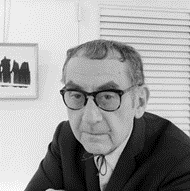
Man Ray (born 1890 – 1976) was an American visual artist, who spent much of his career in Paris. He was best known for his pioneering photography and was a renowned fashion and portrait photographer. He is also noted for his work with photograms (photographic image made without a camera), which he called “rayographs” in reference to himself. He was the son of Jewish immigrants, where his father worked as a tailor and his mother was a seamstress. He studied architecture, engineering and art, and became a painter. He produced major works in a variety of media but considered himself a painter above everything else.
Examples of his work:

Ray wished to distance himself from his family, yet he felt a connection to tailoring as it was a form of art. Growing up, he always displayed artistic and mechanical abilities. In 1904, Ray started attending Brooklyn’s Boys’ High School which provided him with a strong education and which he learnt basic art techniques. While he attended school, he educated himself with frequent visits to local art museums. After his graduation in 1908, Ray was offered a scholarship to study architecture but chose to pursue a career as an artist instead. Man Ray’s parents were disappointed by their son’s decision to pursue art, but they agreed to rearrange the family’s modest living quarters so that Ray’s room could be his studio. Man Ray stayed and lived in the family home over the next four years. During this time, he worked steadily towards becoming a professional painter. Man Ray earned money as a commercial artist and was a technical illustrator at several Manhattan companies.
Ray’s artistic beginnings started during the Dada movement. Shaped by the trauma of World War I and the emergence of a modern media culture, Dada artists shared feelings of disappointment with traditional modes of art making and often turned instead to spontaneous experiments.
The Dada movement:
Dada or Dadaism was an anti-art movement that developed in 1915 with context of World War 1 and the earlier anti-art movement. Early areas for dadaism included Zürich and Berlin. Within a few years, the movement had spread to New York City and a variety of artistic centers in Europe and Asia. To develop their protest, artists tended to make use of nonsense and irrationality.
The art of the movement began primarily as performance art, yet eventually lead to visual, literary and sound media- including sound poetry, cut-up writing and sculpture. Dadaist artists expressed their discontent toward violence, war, and nationalism and maintained political connections with radical politics on the left-wing. Ray was a significant contributor to the Dada and Surrealist movements, although his ties to each were informal.
In 1915, Man Ray had his first solo show of paintings and drawings after taking up residence at an art colony in New Jersey, as he had moved out of his family home in 1913. He produced his first significant photographs in 1918, after initially picking up the camera to document his own artwork.
Surrealism:
Man Ray’s experiments with photography carried him to the center of the emergent Surrealist movement in Paris. Led by André Breton, Surrealism sought to reveal the uncanny truth beneath familiar appearances in daily life. Man Ray proved well suited to this type of art, which led to him being represented in the first Surrealist exhibition with many artists, including Pablo Picasso, at the Galerie Pierre in Paris in 1925.
The Second World War forced Man Ray to return to the United States, where he lived in Los Angeles from 1940 to 1951. From this, he focused his creative energy on painting.
